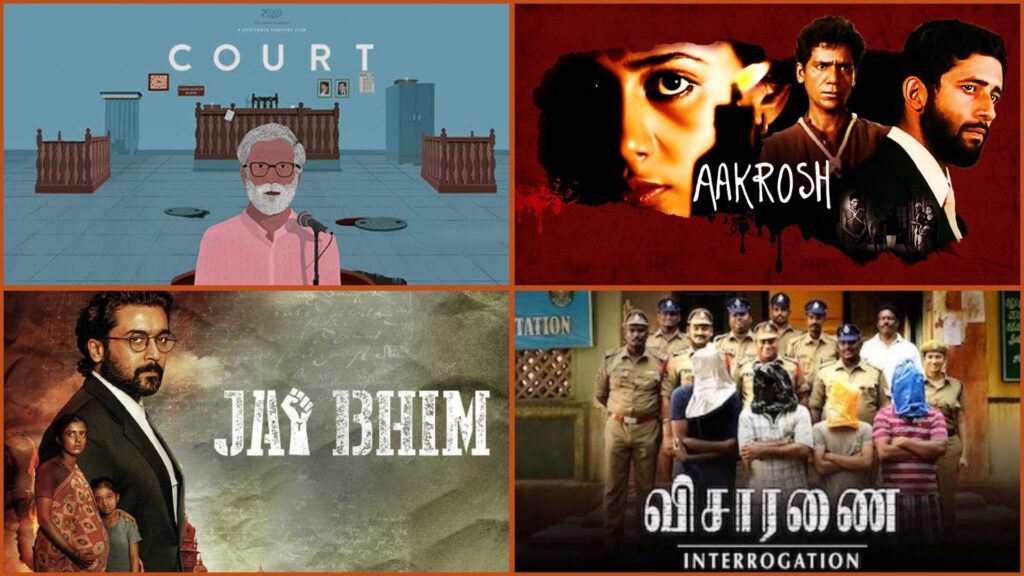Project 39A recommends four Indian films – Court (2014), Visaranai (2015), Jai Bhim (2021) and Aakrosh (1980) – which center the experiences of the most marginalised members of society with the criminal justice system, and raise critical questions about the interaction between state power and structural inequality and its impact on justice delivery mechanisms.
These stories highlight the disproportionate impact of the violence of the system – in the form of custodial torture, fabricated evidence, false prosecutions, as well as its apathy and incomprehensibility – on individuals who have been subject to systemic discrimination due to their socio-cultural identity. These films reflect the visceral alienation experienced by such individuals as they navigate police investigations, communications with their lawyers, or courtroom proceedings. When the legal system, and its inherent inaccessibility, is viewed through this lens, one is confronted with questions about the space for agency of vulnerable individuals within the legal system; the tremendous responsibility on lawyers and judges, who are themselves human and imperfect; and the imagination of an inclusive and effective justice system.

Court (2014, Chaitanya Tamhane)
Court captures the engagement of the court eco-system with Narayan Kamble’s case, where folk singer and activist (Kamble) is accused of abetting a sanitation worker’s (Vasudev) suicide through his “provocative” song lyrics. The film allows a glimpse into the life of each stakeholder, within and outside the court. The coverage of the life of the judge, in particular, reveals his fallibility – his biases and superstitions. This offers a compelling contrast to the expectation of his role in the courtroom as an impartial dispenser of justice. Through a (fairly accurate) depiction of the manner in which evidence is recorded in court, the film highlights the disconnect between reality, witness testimonies and what is finally recorded as legal fact. The trauma of manual scavenging gets lost in legal translation, and Kamble’s steadfast conviction in his music gets interpreted as open defiance against the might of the state – threatening the certainty of his freedom. Court’s depiction of the routine functioning of the legal system dispels any glamourised notions about the administration of justice; and instead reveals the struggles and susceptibilities of the individuals who personify the state.
Visaranai (2015, Vetrimaaran)
Visaranai [The Interrogation] follows three Tamil migrant workers in Guntur, Andhra Pradesh. Their inability to understand Telugu creates several challenges for them, such as finding steady employment and navigating the alienation of being far from home. When they are wrongfully arrested for a theft they did not commit, Pandi and his companions struggle to understand the charges against them. With no legal representation or reliable support networks, the three find themselves at the mercy of the police system. The police, burdened by political pressures and expectations to quickly close cases, subject the detainees to torture for “confessions” and brutally exploit their vulnerability.
Though at times discomfiting to watch, Visaranai unravels the arbitrariness and dark extremes of state power, and the precarity of individuals confronted with it.
Jai Bhim (2021, TJ Ghanayel)
Jai Bhim is a cinematic representation of a 1993 case argued by Retd. Justice K. Chandru during his time as a practising advocate.
When Rajakannu, a member of the Irula tribe, is implicated in a false case and subsequently disappears from police custody, his distraught wife, Sengeni, finds hope for justice in peoples’ lawyer, Chandru. The Irulas (forest dwellers, traditionally engaged in snake catching), are a denotified tribe, whose members continue to bear the stigma of being branded as criminals by an oppressive colonial law. The persistent criminalisation of the group is exemplified by the impunity with which the police infringe their basic rights and routinely entrap them in false criminal cases – a tragedy which consumes Rajakannu and his relatives.
At its core, Jai Bhim, highlights the immense capacity of effective lawyering to represent marginalised voices, render challenge to police excesses, and realise the very essence of the law.
Aakrosh (1980, Govind Nihalani)
Aakrosh’s [Anger] protagonist, Lahanya, an adivasi accused of his wife’s murder, navigates the film in stunned silence. When Lahanya refuses to confide in his idealistic lawyer, Bhaskar Kulkarni, the latter decides to pursue the truth on his own. As the reality of the incident, and the complicity of the powerful actors of the justice system, unfolds, Lahanya’s silence becomes deafening to his young lawyer. Confronted with his client’s harsh circumstances and internal turmoil, Bhaskar’s faith in the justice system is shaken. The violent culmination of the film reveals the extent of Lahanya’s anguish and rage. For Lahanya, the systemic oppression of his community and family is deeply pervasive and immutable, making the very possibility of a just resolution through the legal system an illusion. Aakrosh compels us to interrogate the quality of justice that the law can afford in the face of structural inequality and a compromised system.






